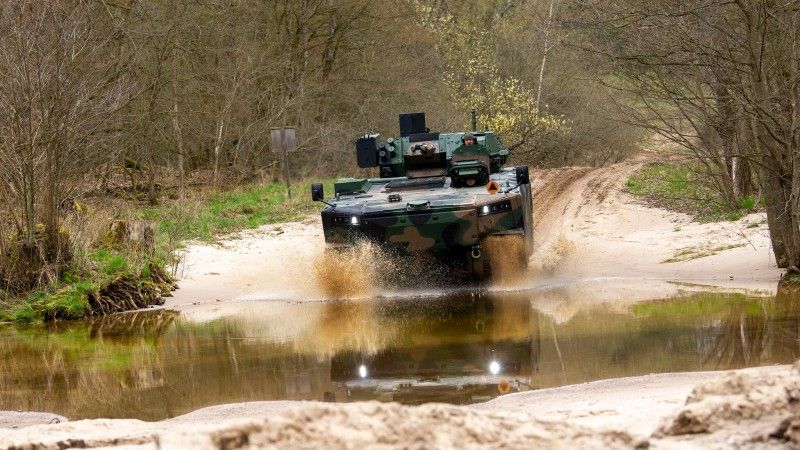Defence Billions from the EU. What Will Poland Buy and How Much Will It Gain? [ANALYSIS]

Photo. Polska Grupa Zbrojeniowa/Facebook
The Council of the European Union today adopted regulations establishing a joint financing instrument for defence procurements — known as SAFE — and Poland will be one of its principal beneficiaries. It is worth considering what Poland might purchase with EU funds and what economic benefits will follow.
SAFE (Security Action for Europe) is one of the key elements of the European Commission’s recently proposed White Paper on security and defence. Under the regulation adopted, over the next four years EU Member States will be able to borrow up to €150 billion on favourable terms for defence purposes. Loans under SAFE can be repaid over up to 45 years, with an initial capital‐repayment moratorium of 10 years—although the longer the repayment period, the higher the overall interest cost will be. The loans will be raised by the European Commission on financial markets and may be used to purchase armaments, distinguishing SAFE from prior EU instruments which were limited to R&D up to prototype level or to building industrial capacity.
Once SAFE enters into force, Member States will have six months to submit preliminary national plans to the Commission, which will then evaluate them. The Council of the EU will subsequently approve implementing decisions on the Commission’s proposal and launch pre-financing up to 15 per cent of the loan, possibly in 2025 for the most urgent programmes. Member States may apply for further tranches twice a year, reporting on programme implementation progress each time. The final approvals for SAFE disbursements must be made by 31 December 2030.
What the SAFE Program Really Is?
SAFE was established as an extraordinary instrument under Article 122 of the Treaty on the Functioning of the European Union in response to a deteriorating security environment in Europe, mainly the threat from Russia and concerns over possible reduced US engagement in the European theatre. Consequently, there was no requirement to consult the European Parliament, and the procedure was completed in under three months.
However, SAFE is time-limited and non-renewable: it is a one–off fund to urgently fill capability gaps. This sets it apart from, for example, the European Defence Industrial Programme (EDIP), which follows the standard legislative process and is subject to much stricter conditions: for instance, one parliamentary committee voted to raise EDIP’s minimum share of European-sourced components to 70 per cent (from the Commission’s proposed 65 per cent, which aligns with SAFE), complicating joint projects with non-EU partners such as the US or South Korea.

Photo. kpr. Sławomir Kozioł / 18 Dywizja Zmechanizowana / zoom.mon.gov.pl
In other words, SAFE loans offer a unique opportunity to boost defence-industry procurements with EU financing on preferential terms. During the legislative process, many of Poland’s demands were addressed—for example, in the first year, single Member States may apply for funding (initially it was envisaged only for joint procurement programmes).
This significant simplification allows other Member States to join any SAFE-funded programme. Since most of Poland’s modernisation projects are built around framework and executive contracts, this should pose no problem: if, say, another EU country wants to buy Polish equipment financed by SAFE, it would simply sign an implementing agreement under the existing framework, which would be amended accordingly. Germany already uses this model—for example, in IRIS-T air-defence system purchases for Slovenia.
Another Polish request that was accommodated is allowing existing defence programmes to be financed under SAFE. This puts Warsaw in a favourable position, as many ongoing programmes may receive retroactive financing. Importantly, funding is not limited to the priority areas defined by the EU (such as ammunition and rocket systems, air defence, drones and counter-drone systems in Group I; artillery, artificial intelligence, electronic-warfare and strategic support in Groups II and III, plus space-capability protection), but also to areas nominated by the Member States themselves.
What Could Poland Gain?
According to statements by representatives of the Polish government—including the Ministry of National Defence—and by Commission officials at a Defence24.pl press briefing in March, Member States will have the final say on which systems receive funding.
So what, then, can Poland finance through the SAFE? Most likely, it will mainly be products of the Polish defense industry (with the possible exception of the Orka submarine program). In addition to submarines, loans may be allocated to:
- Selected elements of the “Eastern Shield” program, including drones and counter-drone systems (and perhaps also Electronic Warfare assets, which the Polish Armed Forces clearly need not only for Eastern Shield)
- New, amphibious Borsuk IFV
- Jelcz logistics vehicles (likely those intended for the Krab, K9 and Homar artillery systems, as well as for Wisła and Narew air-defense systems)
- Polish elements of the Wisła and Narew air-defense systems (including vehicles, but also radars and command modules)
- Artillery Ammunition
- Krab self-propelled howitzers
- Piorun MANPADS
- Rosomak-L wheeled-APC
- Baobab-K scattered minelaying systems
- UAVs, Warmate and FlyEye included
- Piorun MANPADS
It is worth noting that in December 2024 alone, the Ministry of National Defence concluded over PLN 20 billion in domestic contracts (80 KTO Rosomak-L vehicles under the framework agreement for 174 carriers—PLN 4.3 billion; 96 Krab howitzers in four Regina modules, including modernized variants—about PLN 9 billion; the framework covered 152 guns and over 250 support vehicles for K9 howitzers—PLN 8 billion), and essentially each of these contracts can be expanded in scope. This expansion could theoretically occur either by including SAFE financing under the existing implementation contract (thus freeing up funds for the next one), or by financing a subsequent implementation contract based on the existing framework agreement with European funds. As for the Borsuk IFV, we know that 111 vehicles cost PLN 6.5 billion—and the needs of the Polish Armed Forces are much greater, with industrial capacity set to increase.

Photo. M.Dura
A very important beneficiary of the SAFE program could also be air- and anti-drone defense. Note that in December 2023 the Ministry ordered 24 Polish P-18PL radars for PLN 3.1 billion, but “in the queue” are also Passive-Location Radar Systems (which will likely cost much more), as well as as many as 46 multifunctional fire-control radars “Sajna” for the Narew systems. If we include vehicles, it may turn out that only the domestic elements financed by SAFE within the air-defense sector will total over PLN 20 billion. The Orka program alone is worth—conservatively estimated—several tens of billions of zlotys, perhaps even around PLN 20 billion.
Financial Benefits
From this overview, it follows that even if Poland manages to secure over PLN 100 billion in loans (estimates range from a few dozen to as much as PLN 130 billion), that sum could be swiftly “filled” with contracts for equipment already planned for technical modernization and offered by the Polish industry. One could even argue that the SAFE instrument for purchases from the Polish defense industry will function much like the government loans from the USA or the Republic of Korea did for contracts with those countries. As early as 2022 Poland received preferential financing from Seoul of USD 9 billion for the first stage of implementation contracts. In 2024, financing was approved for contracts worth another USD 4 billion (the second stage of K9 and Homar-K howitzers), and currently—according to Defence24.pl, Deputy Minister of Defense Paweł Bejda—USD 5 billion is available to the Polish government for K2 and K2PL tanks, along with a technology transfer. The scale is thus comparable.
But how much will SAFE loans cost? That depends primarily on their repayment schedule. Note that an interest rate of 3.3 percent, and the very form of a loan (compared, say, to bonds), is advantageous. For example, on a sum of PLN 100 billion, the total cost of a loan at 3.3 percent (excluding administrative fees) would be PLN 109.5 billion over 5 years and PLN 117.4 billion over 10 years. SAFE will almost certainly be managed by the Armed Forces Support Fund.
By comparison, interest alone on 5-year fixed-rate bonds at 5 percent would amount to PLN 25 billion (and they’re usually sold below par, incurring extra costs for the state), and over 10 years—PLN 50 billion, meaning total costs of PLN 125 and 150 billion respectively. There have even been cases where the Armed Forces Support Fund issued US-dollar-denominated bonds at even higher interest rates (e.g. 6.25 percent).
Thus, assuming identical repayment periods, Poland would pay several to several dozen billion zlotys less for SAFE loans than if it raised the money on financial markets. Another scenario is likely as well: capital repayments under SAFE could be deferred—for example, over 10 years and spread out (even up to 45 years). In that case, the nominal cost would be higher, but on the other hand there would be no need to “roll over” debt by issuing new, high-interest bonds to repay the old ones. With a structural public-finance deficit, there’s no other solution.
So what will the SAFE instrument be? Most likely a very favorable option for financing purchases from the Polish defense industry. What will matter are the speed of contracting and the European Commission’s approval of agreements, since “national” (not just joint) purchases can only be financed for one year. It can certainly provide great support to the Armed Forces Support Fund and to the Ministry of Defence’s budget, which is increasingly burdened by current expenditures.
Although SAFE-funded procurements should be executed as quickly as possible, this does not remove the need to consider the structural strengthening of the Ministry’s finances, given the costs of equipment maintenance, infrastructure, and implementation of new technologies—especially in light of their accelerated development following the full-scale war in Ukraine. All of this comes at a time when public finances are heavily strained. SAFE represents a one-time opportunity for the Polish industry and the Ministry of National Defense’s budget—crucial and indispensable to seize—but it does not eliminate the structural challenges of financing Poland’s security system.



